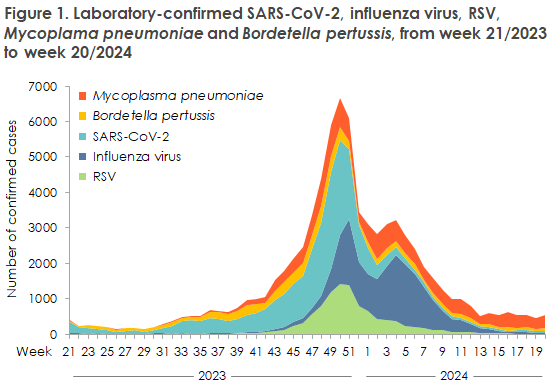No 26 - 2024
Integrated surveillance of respiratory infections in the 2023/24 season
Integrated surveillance of respiratory infections in the 2023/24 season
In the autumn of 2023, Statens Serum Institut (SSI) expanded the existing surveillance of respiratory infections, which is now presented as a combined surveillance of COVID-19, influenza and diseases caused by RSV as these are the respiratory infections that impose the greatest disease burden on patients and on the healthcare system due to hospitalisations. Other respiratory infections are included when the incidence is increased. The results from this surveillance are published weekly on the SSI's website, along with an assessment of the development of infections and hospitalisations for the circulating viruses and bacteria.
For a detailed review of the results of the integrated airway monitoring, please refer to the SSI website.
The respiratory season 2023/24 was characterised by the simultaneous circulation of the five major respiratory pathogens. In July 2023, the incidence of Bordetella pertussis began to increase (the bacterium that causes whooping cough), followed by an initial increase in Mycoplasma pneumoniae incidence in August 2023. Both of these respiratory bacteria have been detected only at very low levels since the initial COVID-19 restrictions were introduced in March 2020. In August 2023, an initial increase was also observed in the incidence of SARS-CoV-2, followed by increased circulation of RSV in October and influenza virus in November, Figure 1. The circulation of these five respiratory pathogens peaked in weeks 49-51 of 2023, with SARS-CoV-2 as the dominant cause of respiratory infection. In January and February 2024, respiratory infections were most frequently caused by the influenza virus. Since April 2024, the incidence of respiratory infections has remained at a low level, with the exception of M. pneumoniae, which in May 2024 continued to be elevated with between 300 and 450 new weekly cases.

An increased incidence of respiratory infections in the autumn and winter months is no different from before the pandemic, when influenza, RSV and M. pneumoniae circulated every autumn and winter. The new element was a considerable contribution from COVID-19, which accounted for 32% of respiratory infections and 49% of hospitalisations caused by the five major respiratory infections in the 2023/24 season.
(The SSI Respiratory Team: H.-D. Emborg, J. Grau, I.R. Moustsen-Helms, F.K. Lomholt, F. T. Møller, L.S. Vestergaard, L.W. Krogsgaard, A. Gudde, B. Søborg, H. Bang, J. Nielsen, C. Kjelsø, A.C.M. Nordholm, C.H. Hansen Department of Infectious Disease Epidemiology and Prevention, R. Trebbien, C.K. Hjulsager, A.B. Botnen, J.S. Krog, M. Rasmussen, U.V. Schneider, Department of Virus and Microbiological Special Diagnostics, K.L. Møller, Data Integration and Analysis, L.E. Christiansen, Epidemiological Research)